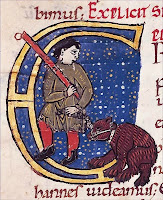I say "seems to offer" because wilderness and wildness can be idealized. A predator in the wild might appear "free" to us, but how "free" is the prey that is being chased?
 |
| Alexis de Tocqueville (1850) |
We humans, like all living beings, depend upon other entities. Despite that dependence, every living being -- if its life is able to reach a fullness -- must still obtain a type of freedom from something in its past. A chick needs to hatch and leave its shell behind. So also must adolescent humans find some separation from their parents.
That ambiguity regarding freedom can lead to human hypocrisy. De Tocqueville made a wry observation about American society. He said that when Americans are criticized for their behavior, they protest, "I have a right to do so" -- whereas when they see someone else doing something they do not like, they exclaim, "There ought to be a law!"
Paradoxically, we can find a kind of release, a kind of freedom, when we yield to some forms of dependence. The bird finding the breakfast upon which its life depends is simultaneously gaining a temporary freedom from hunger. And vice versa: The being that is finding a new form of freedom is at the same time developing new relationships with new forms of dependence. That young adult moving out of its parents' home now depends upon friends or a job to sustain the newfound freedom.
 Self-actualizing is an ever-ongoing combination of freedom and ties, ties and freedom, all in motion. We might employ that word "wild" in a slang sense by remarking upon what a "wild and crazy" kind of life it is to exist on this planet!
Self-actualizing is an ever-ongoing combination of freedom and ties, ties and freedom, all in motion. We might employ that word "wild" in a slang sense by remarking upon what a "wild and crazy" kind of life it is to exist on this planet!
~~~
What do you think the purpose of freedom should be? Can you give an example?
(The Ronald quote is from Words for the Wild, ed. Ann Ronald. © 1987. p. 237.)
(The Tocqueville quote is from his Democracy in America, as quoted in
Wilderness and the American Mind by Roderick Nash, © 1982. p. 23.)
Wilderness and the American Mind by Roderick Nash, © 1982. p. 23.)
(The quote by Lord Byron is from his poem Childe Harold's Pilgrimage, canto IV, st. 178. [1817].)
![(illustration from "The Story of the Three Bears" [1900] by Leonard Leslie Brooke.) Cute in cartoons, but...](https://blogger.googleusercontent.com/img/b/R29vZ2xl/AVvXsEiBRhD7ZlMSaJ5QCR8B9SMowhcbewWTSH-Qyg0u9IAkamnQ8v6dBSfFT2BosqCr2hwR5-ag3SOrwaftx2bg-CIFnTFd2x6lK-53VOPOoftv5VCh0uuomz2Jd0erZ-uts3V6Dqs9JvL9-nM/s200/Three+bears+getting+porridge.jpg)

![(painting of Russian brown bear family by A. N. Komaro, from "Mammals of the Soviet Union" [1988] by V. G. Heptner, et al.) A life of their own.](https://blogger.googleusercontent.com/img/b/R29vZ2xl/AVvXsEime8H1eBiW4pKYUlcF_TdQd2ybuCbOpHSG_DVKwRWSf4tS1QKaR-vNxwElibO-ZB2tLlCR6HHOahx41_qOkdYf1TYBBklMVm_G9mxgzqoqNXzSSwT3I7zkioh8bR2DHXBCjPdA5-r0KzA/s200/mother+bear+and+two+cubs+by+trees.jpg)